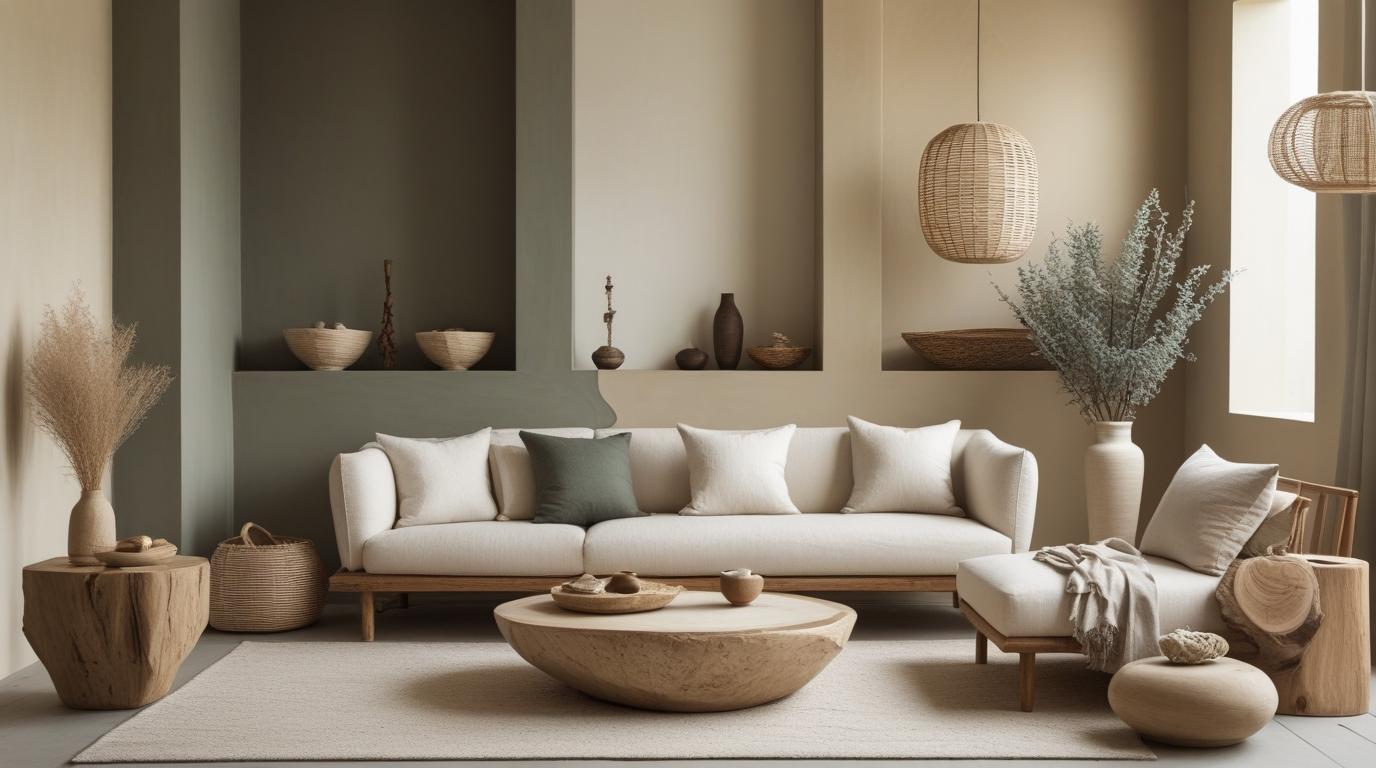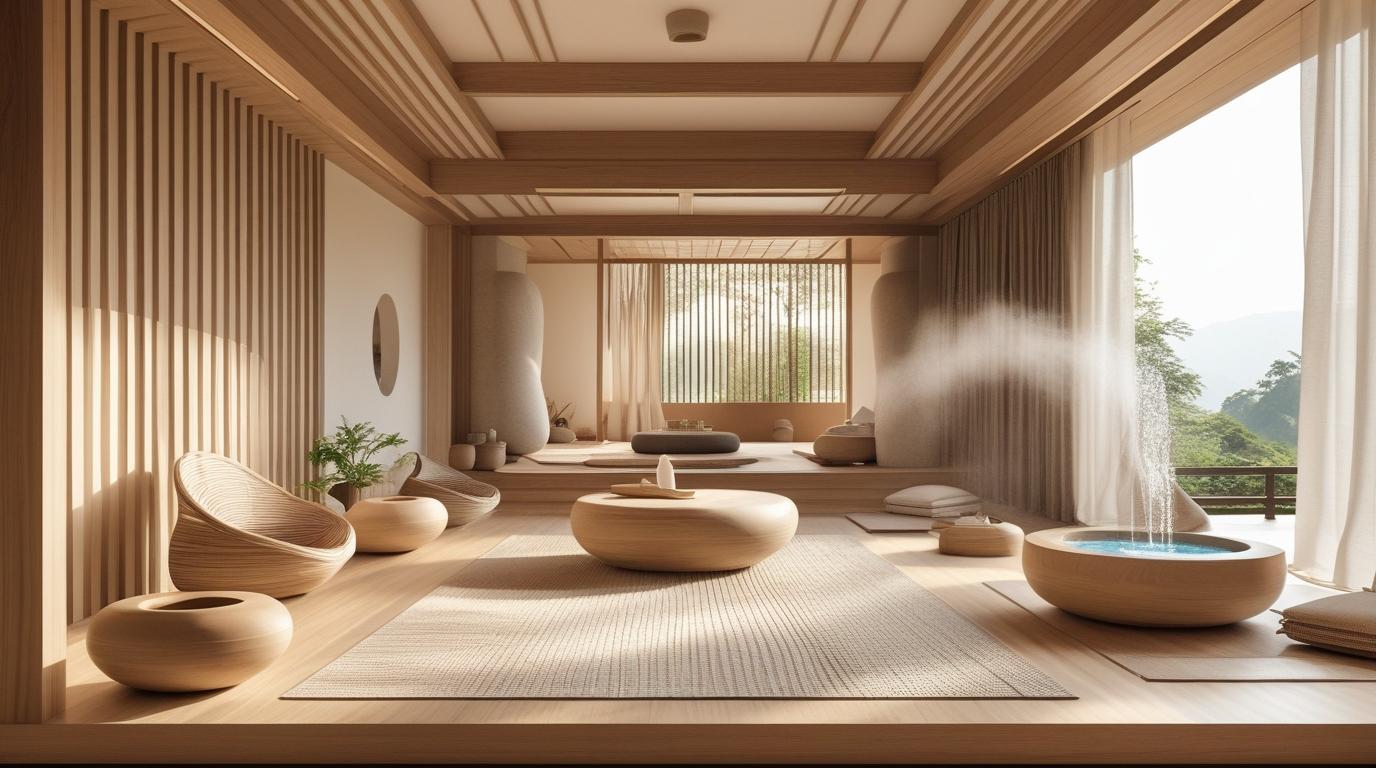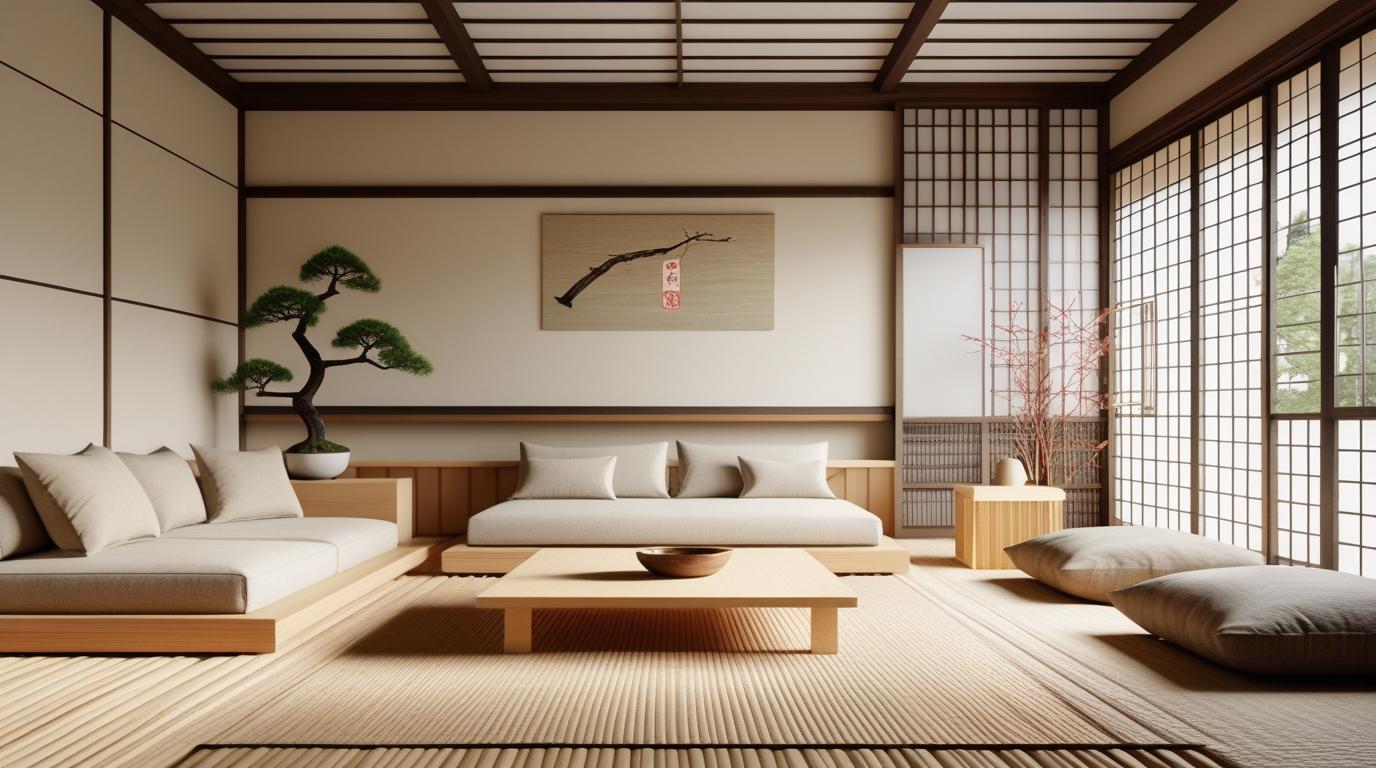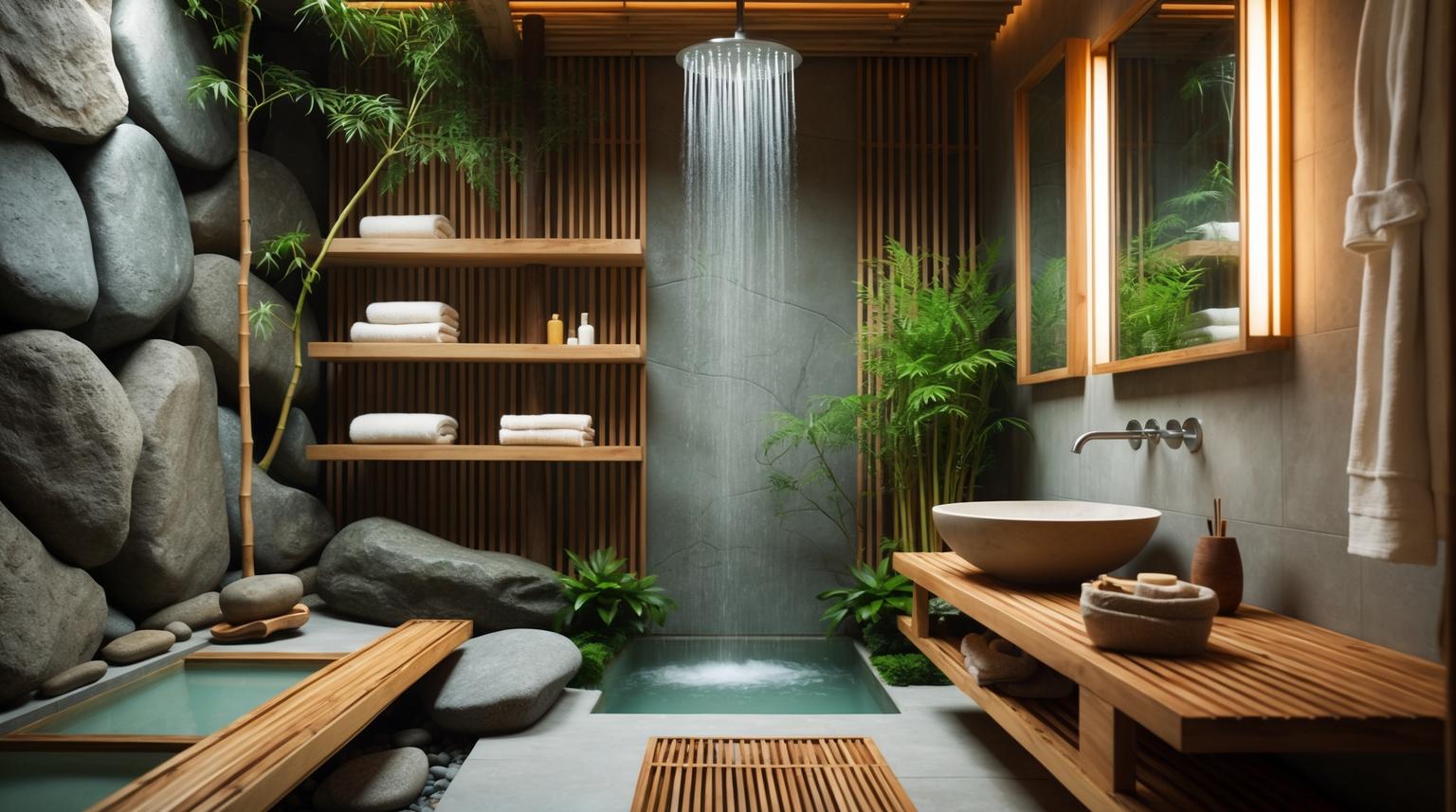5 min. reading
A Comprehensive Guide to Zen Interior Design
Juliy Cherevko
CEO paintit.ai

Page Contents:
- 1. What is Zen Space?
- 2. The History of Asian Zen Style
- 3. Fundamental Principles of Zen Interior Design
- 4. How to Create a Zen Room
- 5. How Paintit.ai Can Help You Design Your Zen Space
- 6. Conclusion
In a world over-stimulated with digital noise, visual chaos, and constant movement, our homes need to be sanctuaries of calm. Zen interior design is an old-fashioned solution-a way of stripping away the unnecessary and introducing peace, harmony, and clarity into your home. Drawn from centuries-old Japanese philosophy and adapted for modern living, this book explores how to create a Zen space that promotes well-being, mental clarity, and beauty.
What is Zen Space?
Zen space is a term used to define an interior that encourages peace, simplicity, and awareness. Derived from Japanese Zen Buddhism, it eliminates the clutter-physical and mental-to create an environment where quiet prevails. In modern interiors, a Zen space welcomes serenity through the adoption of minimalism, natural finishes, and functional design. It's not necessarily about beauty; it's about the feeling space creates.
Designing a Zen interior design requires creating spaces with the intent for peace and introspection, wherein every object plays a purposeful role and not one thing more. Whether it's building an actual meditation space or simply need a calm bedroom, a Zen room is simply about intention and serenity.
The History of Asian Zen Style
Asian Zen style originated in ancient Japan and drew a lot of influence from Zen Buddhist beliefs. The style was initiated by the Zen monks, who constructed temples in terms of natural materials, earthy hues, and an admiration for simplicity. Throughout centuries, Zen interiors eventually extended to home architecture-emphasizing emptiness instead of richness, living in harmony with nature, and embracing imperfection, mirroring the general philosophy of wabi-sabi.
Now, Zen interior design transcends cultural boundaries. It blends traditional Japanese with modern minimalism, offering a solution to overstimulated modern living. The underlying idea remains the same: design on purpose, slice through distractions, and value tranquility.
Fundamental Principles of Zen Interior Design
The foundation of Zen style interior design lies in balance, intention, and harmony with nature. These are the cornerstones that guide all elements of a Zen home, from material selection to space usage. In contrast to shallow decorating trends that will soon be outdated, Zen design principles are founded on creating lasting peace through thoughtful restraint and harmony-rich environments. Let's break the key points that comprise this serene look.
Simplicity and Minimalism

Minimalist Zen home decor is founded on the premise that less really is more. Everything in the room has a purpose. There are no clashing prints and extra knick-knacks-just clean lines, uncluttered countertops, and functional furniture pieces. Simplicity here is anything but boring-it's liberating. It eradicates visual and mental clutter.
This design philosophy also encourages mindful consumption-buying fewer but higher-quality items that align with your values and aesthetic. Furniture tends to be low-profile and unobtrusive, allowing the architecture and natural light to take center stage. Even decorative accents, such as a single ceramic vase or bonsai tree, are chosen with care to preserve the room's balance and meaning.
Natural Materials

Zen spaces rely heavily on natural, physical materials: wood, stone, bamboo, cotton, and linen. These materials anchor us and contribute to the authenticity of the space. A wooden bench, a stone sink, or a linen wall doesn't just serve a function-they bring texture and earthy energy to the space.
Natural materials also engage the senses-cool stone underfoot, warm wood grain to the touch, the light rustle of linen in the breeze-making the environment feel more alive and immersive. These materials age gracefully and often improve in character over time, reflecting the Zen philosophy of finding beauty in imperfection and transience.
Neutral Color Palette

Color evokes mood in any room. In Zen interior design, neutral colors are the rule-beiges, pale greys, muted whites, and earthy browns. These colors don't draw attention to themselves; instead, they serve as a backdrop for relaxation. Soothing greens or charcoal accents add visual interest without breaking the peace.
The goal is to cultivate a visual atmosphere that supports serenity and reflection. These soft hues reflect natural elements-stone, sand, wood, and fog-enhancing the organic feel of the space. Avoid high-contrast combinations or overly saturated tones, which can create unnecessary tension. The palette should feel cohesive and flow from room to room, reinforcing the sense of unity throughout the Zen home.
Balance and Harmony

Creating a Zen space is all about achieving harmony-between material, texture, and spatial movement. Asymmetrical balance, negative space, and organic shapes avoid visual disarray. The design should allow for a smooth transition from one area to the next, so nothing is cluttered or overly ornate.
Harmony also extends to sensory elements-sound, scent, and temperature. Consider using soft ambient sounds like flowing water or nature-inspired audio, subtle aromas from essential oils, and natural ventilation or gentle airflow. These aspects work together with visual harmony to create a fully immersive environment that supports focus, relaxation, and wellbeing.
Natural Light

Zen lighting is indirect, ambient, and subtle. The optimal lighting is from natural sources, softened by sheer curtains or bamboo blinds. In the evening, employ warm-toned lighting features like paper lanterns or low-voltage LED strips to preserve the tranquility of the space.
Avoid harsh overhead lighting or stark contrasts that may create visual strain. Instead, aim for layered lighting-combining floor lamps, wall sconces, and accent lights to create depth and warmth. This approach allows for flexibility while maintaining a peaceful, low-stimulation environment that complements the principles of Zen interior design.
How to Create a Zen Room
Designing a Zen room is about choosing an atmosphere that encourages calm, awareness, and intention in each and every detail. Whether you are remodeling one room or your entire house, the concept is to prioritize function, flow, and feeling above all. A genuine Zen interior forgoes clutter, encourages quality over quantity, and uses design to support wellbeing. In the following sections, we condense how to introduce Zen principles into every corner of your home.
Zen Living Room

A Zen living room is the hub of tranquility in your living space. Start with decluttering-leave out what does not add value. Employ a low-slung couch in a neutral shade, a natural fiber rug, and a wooden coffee table with clean lines. Add a single piece of art or a plant as a focal point. For Zen living room ideas, consider floor seating, shoji screens, or tatami mats to enhance authenticity.
Zen Bedroom

Sleep in a Zen bedroom is sacred. Choose a minimalist bed frame, preferably wood, with crisp white or beige bedding. Nightstands should be entirely bare except for what is strictly necessary. Softer, layered lighting is a bonus ambiance, and blackout curtains or linen drapes regulate light and temperature. This is the ultimate zen room design for deep sleep and quiet introspection.
Zen Bathroom

A Zen bathroom is a personal spa. Utilize materials like river rocks, wood strips, and ceramic sinks. Open shelving, soft towels, and uncluttered fixtures provide an aura of cleanliness and clarity. A rainfall shower, combined with plants and dim lighting, makes mundane routines mindful rituals.
Zen Kitchen

Zen kitchen design balances functionality with tranquility. Keep countertops clear and use open shelving for the minimal essentials. Choose a muted color palette punctuated by wood and stone. Natural light and concealed storage enhance the flow, even making cooking a peaceful endeavor.
How Paintit.ai Can Help You Design Your Zen Space
Paintit.ai leverages artificial intelligence to bring your modern Zen house design to life-without the stress. Our technology helps you envision Zen interior design ideas that are compatible with your home's floor plan, lighting, and color scheme. Whether you're planning a full overhaul or just browsing zen ideas for one room, we provide realistic 3D visualizations and floor plan suggestions in seconds.
Our software allows you to easily create a Zen room. Upload an image, select your style (e.g., minimalist Zen interior design), and our AI will suggest decor, colors, and furniture arrangements. Need inspiration? Our curated library of zen home design inspiration ensures you never get stuck.
Conclusion
Zen interior design is more than a style-it's a manner of existing in greater harmony with less. By embracing simplicity, nature materials, and well-considered design, you're building a space that nourishes the soul. Whether you're learning to create a Zen room or renovating your entire home as a refuge, remember: serenity starts here.
With Paintit.ai software, it has never been easier to create a serene, harmonious, and beautiful Zen interior. Begin creating a room of Zen that embodies your faith and brings mindfulness into everyday living.
Trending
Preppy Bedroom Ideas: How to Master the New Traditionalism
Expert Review of AI Virtual Staging Platforms for Precise Furniture Selection
What Are the Best Spacely AI Alternatives?
The Future of Design 2030: How Agentic AI & Paintit.ai Will Transform Your Home
Romantic & Cozy Navy Blue Bedroom: The Ultimate 2025 Design Guide
Related articles

9 min read
Top 6 Homestyler Alternatives: Best Tools for Instant Interior Design
Searching for Homestyler alternatives? We compare the 5 best tools of 2025. From complex manual modeling to instant AI design with Paintit.ai. Read the review.
Juliy Cherevko
CEO paintit.ai

7 min read
Preppy Bedroom Ideas: How to Master the New Traditionalism
Discover 15 trendy preppy bedroom ideas for 2025. Learn how to mix patterns, choose perfect preppy wall colors, and style iconic furniture
Juliy Cherevko
CEO paintit.ai

16 min read
Expert Review of AI Virtual Staging Platforms for Precise Furniture Selection
Compare AI virtual staging platforms focused on furniture style selection, customization features, pricing, speed, and usability for property design
Juliy Cherevko
CEO paintit.ai

6 min read
What Are the Best Spacely AI Alternatives?
s Spacely AI worth it? Discover the best alternatives for architects and agents. Detailed review of Paintit.ai, RoomGPT, and others
Juliy Cherevko
CEO paintit.ai

5 min read
The Future of Design 2030: How Agentic AI & Paintit.ai Will Transform Your Home
Tired of managing renovations? By 2030, Agentic AI will do it for you. Explore Paintit.ai’s vision for autonomous design and the Agent-to-Agent economy
Juliy Cherevko
CEO paintit.ai

7 min read
Romantic & Cozy Navy Blue Bedroom: The Ultimate 2025 Design Guide
Create a romantic cozy navy blue bedroom with our expert guide. Discover 10 luxury dark blue ideas, best paint colors, and lighting tips for a dreamy sanctuary
Juliy Cherevko
CEO paintit.ai